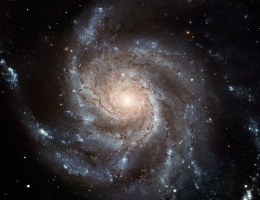Spiral Galaxy

Credit: NASA/HST
Spiral galaxies are flat disks of stars, gas and dust. The disk rotates around a bulge of much older stars. Around the main disk is a much fainter halo of stars. Most of these halo stars live in globular clusters. Up to 65% of the galaxies we can see are spirals.
Spirals are called after the spiral structures (or arms) that come out from the central bulge into the disk. These arms are often lumpy. They are the site of new stars being born. The areas where stars are forming are brighter than the surrounding disk. This is because of the young, hot, blue stars which live within them.
Because these galaxies still have lots of gas and dust, they are thought to be quite young compared to elliptical galaxies. In fact, many astronomers believe that over time, spirals will evolve into ellipticals.
Spiral galaxies are mostly found in low-density regions of the Universe (i.e. with not many other galaxies nearby). It is rare to find them in the middle of galaxy clusters. Our own galaxy, the Milky Way, is thought to be a spiral galaxy with a central bar.

